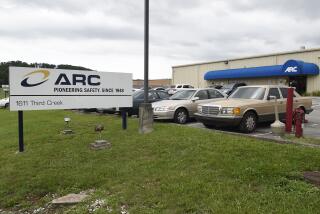New Voluntary Curb on ATVs Upsets Critics
- Share via
The U.S. Consumer Product Safety Commission on Thursday urged the voluntary removal from the market of three-wheel all-terrain vehicles (ATVs) intended for use by children under 12.
The three-member commission, meeting in Bethesda, Md., also chided the motorcycle industry for failing to move more quickly to get the three-wheelers out of the hands of youngsters and for not formulating better voluntary safety standards for ATVs intended for adults.
Opponents Unsatisfied
But in two related votes that immediately roused the ire of medical groups and a congressional subcommittee, the commission pointedly failed to couple the call for voluntary prohibitions against selling children’s models with any specific resolution to ban them from the market if manufacturers don’t act. Moreover, while the commission voted unanimously to have its staff draft a letter to ATV manufacturers expressing “the commission’s displeasure” that the companies have not yet introduced adequate voluntary safety standards, the agency gave no hint it would do anything more to force ATV makers to implement more effective provisions.
In both federal government data and reports published in a variety of medical journals, ATVs have been linked to 85,900 injuries a year and at least 559 deaths in the last five years.
The chairman of an American Academy of Pediatrics task force, which last month harshly criticized the federal agency for not ordering a recall of all three-wheel ATVs and banning their further manufacture, called the Thursday commission action “terrible.” And the chief counsel of a House subcommittee that has been trying to pressure the commission to act on ATV safety called the new action “preposterous and inadequate.”
Industry’s Viewpoint
Both the pediatrics academy’s Dr. Joseph Greensher and Ted Jacobs, senior counsel to the House government operations subcommittee, noted that the commission had not even fully implemented a staff recommendation that calls for voluntary withdrawal from the market of machines intended for children to be coupled with a resolution to ban them outright for children under 12 if the industry failed to act.
The ATV industry, however, made it clear that little is likely to result from the commission votes. Paul Golde, director of safety standards and technical programs of the Costa Mesa-based Specialty Vehicle Institute of America, responded that, despite the contentions of the commission and other organizations, “the children’s ATVs are possibly the safest ATVs made.”
“The commission’s own statistics show kids are not hurt on the small models, they’re hurt on the adult ones,” Golde said. Within the last few weeks, ATV manufacturers have responded to the controversy by insisting their products are “absolutely” safe and contending that injuries to children are most often the fault of irresponsible parents, not unsafe vehicle designs. The new commission votes made up the latest development in a festering controversy over ATV safety that has become a rallying point for opponents of the Reagan Administration’s stated preference for voluntary action by private industry in safety matters, as opposed to government safety regulation.
Three different medical groups--the pediatrics academy, the American College of Emergency Physicians and the American Academy of Family Physicians--have all excoriated the government for failing to act in the ATV controversy.
‘Message Is Clear’
Despite the immediate criticism, Terrence Scanlon, chairman of the commission, depicted Thursday’s action as a significant step. “The message is clear,” Scanlon said. “The ATV is not just another little tricycle that any child can safely ride. Even the smallest ATVs . . . can tip over or roll over, bringing serious harm to even the most capable of child riders.”
The commission also voted to urge state legislatures and regulatory agencies to intensify their ATV safety campaigns. The commission urged more and better warning labels for ATVs and criticized industry groups for not moving quickly enough to develop voluntary safety codes pertaining to labeling of the products, training standards and setting a minimum age for operators.
Expert panels have been split between a 12-year and a 14-year minimum age--though most physician organizations have said minimum age laws would do little good because they would be unenforceable in most situations. An industry-drafted model state ATV law, however, sets no legal minimum age, calling instead for children under 14 to ride only under supervision of an experienced adult.
The American Academy of Pediatrics’ Greensher asserted that voluntary ATV safety steps had been urged repeatedly starting at public hearings held by the safety commission in 1985, but he complained no effective voluntary regulatory program has been introduced.
“Now, hundreds of deaths and tens of thousands of injuries later, we are right back, still asking them (the industry) voluntarily to do something that they haven’t done,” Greensher said. “It’s totally contrary to consideration for the injured, maimed and killed children to still sit and ask industry to voluntarily withdraw this or (the commission will) look at the problem again.”
Jacobs agreed, contending that “on the face of it, without anything further, what they (the commission) have done today is entirely inadequate and thoroughly preposterous given the nature of a very significant risk of people dying and being injured every day from ATVs.”
And Dr. Michael Ervin, president of the American College of Emergency Physicians, said his organization is “very disappointed that the commission chose to back as far away from (the recommendation that children’s models be banned outright) as they have. The commission had an opportunity to make a significant contribution in the area of child safety, and didn’t.”






